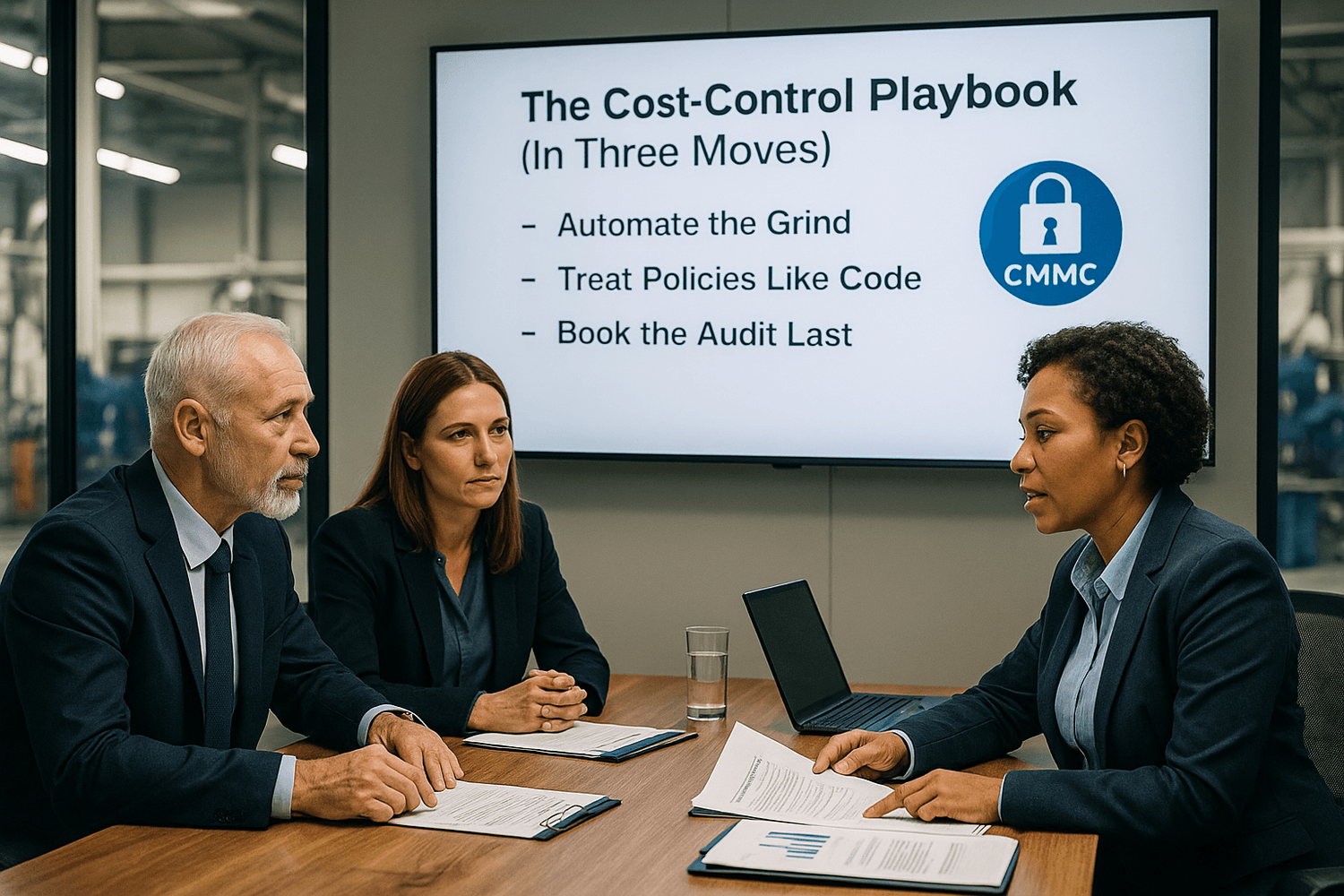“Sticker-Shock” No More: A Practical Budget & Tool Review for CMMC-Bound Contractors
The Pain Point—Compliance Sticker Shock
Talk to any manufacturing VP or IT lead inside the Defense Industrial Base (DIB) and you’ll hear the same groan:
“We want to stay in the DoD pipeline, but we’re staring at a six-figure bill to get through CMMC. Where does all the money actually go—and how do we trim it without cutting corners?”
That fear is real. Gap analyses, policy writing, hardware upgrades, and a C3PAO audit can balloon past $150 k for even a 40-seat shop. Many firms respond by freezing bids, letting lucrative contracts slide to better-prepared competitors.
The good news: most of that spend isn’t mandatory—it’s inefficiency tax. If you treat CMMC like a one-off paperwork sprint, you’ll pay through the nose. If you invest in the right tools and workflows early, you can chop 40-60 % off the lifetime cost and still ace the audit.
This post maps out where the money leaks, how to budget realistically, and which tools actually drive ROI (versus shiny dashboards that look great in demos but add zero audit value).
Follow the Money—Where CMMC Budgets Get Torched
Manual Evidence Wrangling
Teams burn hundreds of hours screenshotting console pages, renaming log files, and tracking artefacts in monster spreadsheets. Labour, not licensing, kills the budget here.Consultant-Driven Policies
External writers charge $150–$250 per hour to “tailor” stock policies. The output is often a pile of PDFs no one can maintain.Over-Provisioned Tech
Large MSSPs upsell SIEMs, zero-trust gateways, and MDR bundles sized for Fortune 500s. Small contractors pay enterprise pricing for capacity they’ll never approach.Auditor Delays
Agenda slips cost real money—idle staff, extended war-room hours, even lost bonuses if the cert isn’t in place for a proposal deadline.
Add a C3PAO fee ($100 k+ for Level 2) and you see why finance teams panic.
The Cost-Control Playbook (In Three Moves)
Move 1: Automate the Grind
Every minute your sysadmin spends exporting logs is a minute not spent closing vulnerabilities. The fix is evidence automation:
Agent-based collectors (Windows Event Forwarding, Filebeat, OSQuery) stream directly to a GRC platform.
API pulls harvest MFA stats, asset lists, and patch status from M365, Intune, or CrowdStrike nightly.
Auto-tagging maps the artefact to the specific 800-171 control so auditors don’t need a treasure map.
Savings: Teams report 50-70 % reduction in prep hours—roughly $25 k on a typical project.
Move 2: Treat Policies Like Code
Copy-pasted PDFs rot the second an engineer tweaks a workflow. Instead:
Use a template generator that merges your org variables (headcount, cloud stack, physical sites) with plain-English policy blocks.
Store in version control (Git, SharePoint, Confluence) with change history.
Assign a policy steward—updates become a sprint task, not a special project.
Savings: Cut consultant drafting hours in half; ongoing maintenance drops to minutes per quarter.
Move 3: Book the Auditor Last
Many contractors schedule the C3PAO six months out “to lock the date” and then scramble. Every reschedule fee and open-ticket hotel room chips away at margin. Flip the order:
Build your artefact library.
Run an internal “red-team” dry run.
Then lock in a C3PAO slot when you know you can pass.
Savings: Avoid late-stage remediation sprints ($1 k+/day in overtime) and reschedule penalties ($5 k–$10 k).

Tool Categories That Actually Matter
Evidence Automation & GRC Dashboards
Must-have: API log pulls, lightweight agents, control-to-artefact mapping, one-click C3PAO export.
Good options: TryComplai, SecureFrame, Totem.
Watch out: Slick dashboards that still require manual uploads—always test with real logs.
Policy Generators
Must-have: Organisation variables, NIST 800-171 baseline templates, built-in version history, e-signature support.
Good options: TryComplai, ComplianceForge, Haekka.
Watch out: Static boiler-plate templates that drop you back into PDF hell.
Asset & Patch Management
Must-have: Real-time inventory, “CUI” tagging, 14-day critical-patch SLA tracking.
Good options: NinjaOne, Intune + Azure Update, ManageEngine.
Watch out: Tools that can’t tag CUI assets—scope confusion kills audits.
Budget Tracking & ROI Calculators
Must-have: Line-item cost templates, remediation-cost estimator, live SPRS-delta view.
Good options: TryComplai’s built-in module, or a transparent Google Sheet.
Watch out: MSSP “calculators” that hide labour or license mark-ups in fine print.
Field Test—TryComplai in a 60-Seat Machine Shop
An Ohio-based CNC shop with roughly 60 endpoints had nine months to nail Level 2 certification. A traditional consultant quoted about $180 k for the full journey. By switching to a TryComplai-first workflow, the team slashed nearly forty percent of that spend. Here’s the cost story, line by line:
Gap analysis and asset inventory
Consultant approach: close to $20 k for an external assessment.
TryComplai approach: internal staff used the platform’s auto-collector—≈ $6 k in labour time.
Policy library creation
Consultant: roughly $18 k for custom drafting.
TryComplai: generated baseline policies in minutes and had SMEs review them—≈ $3 k.
Evidence collection and organisation
Consultant: manual screenshots and log exports ballooned to ≈ $42 k.
TryComplai: agents and API pulls did the heavy lifting —$7 k worth of staff time.
C3PAO preparation and coordination
Consultant: about $35 k in meeting time, status reports, and schedule wrangling.
TryComplai: the team handled prep with occasional coaching calls—$12 k.
Totals before the audit fee
• Traditional path: ≈ $115 k
• TryComplai path: ≈ $28 k
Add the fixed C3PAO audit itself (around $105 k), and the entire project closed just under $135 k—versus the original $220 k projection. The lion’s share of the savings came from labour hours eliminated by evidence automation and policy generation, proving that smart tooling can turn CMMC from a budget buster into a manageable line item.

ROI Math—What the CFO Really Cares About
The finance team isn’t looking for a per-seat price tag; they want proof that compliance investments pay back. Frame the value in three dimensions:
Labour Efficiency
Track hours saved on evidence gathering, policy maintenance, and audit prep. Even modest gains free up engineers for revenue-generating work.
Risk Reduction
Map each closed control to the business impact it mitigates (IP theft, bid disqualification, downtime). Lower residual risk shows up as fewer unplanned expenditures.
Contract Velocity
Faster, cleaner audits mean you can bid on more opportunities and avoid “conditional award” delays that stall cash flow.
Summarise these gains in a one-page dashboard and you’ll have the story the CFO needs—without quoting a single licence number.
Implementation Roadmap—90 Days to Go-Live
Month 1 – Foundation
Deploy log collectors and connect core SaaS platforms.
Import the asset inventory and tag anything that touches CUI.
Auto-generate baseline policies and circulate for approval.
Month 2 – Control Closure
Enforce MFA and close high-value controls (logging, backups, patching).
Map artefacts to NIST 800-171 families; open POA&Ms for any gaps.
Kick off a weekly sprint board to drive remediation.
Month 3 – Audit Readiness
Run an internal mock audit using the platform’s C3PAO share portal.
Freeze change windows, finalise evidence packs, and refresh your SPRS score.
Book the real C3PAO assessment only after you can pass on the first try.
Summarise these gains in a one-page dashboard and you’ll have the story the CFO needs—without quoting a single licence number.
Common Objections (and Why They’re Weak)
“Our MSP does security; we don’t need another platform.”
MSPs keep systems running. They don’t produce control-mapped evidence bundles or real-time SPRS dashboards. A purpose-built workspace complements, not replaces, your MSP.
“Automation won’t capture our unique workflows.”
Automation grabs artefacts; humans provide context. The platform handles the rote collection while your SMEs explain why each control fits your environment.
“We’ll start automating after the first audit.”
Spreadsheet debt compounds. Every manual artefact today is a missing log tomorrow. Automating from day one prevents an expensive do-over at recertification.

Quick-Take Summary: “Sticker-Shock” No More—A Practical Budget & Tool Review for CMMC-Bound Contractors
Problem in focus:
Small and mid-sized Defense Industrial Base (DIB) contractors fear six-figure price tags for CMMC Level 2. The real budget killer isn’t licensing—it’s hours lost to manual evidence wrangling, PDF-based policies, and rushed audit prep.
Where money leaks:
Manual screenshots and log exports
Expensive consultant-written policies
Over-sized security tech bundles
Scheduling (and rescheduling) C3PAO audits before you’re ready
Three cost-control “moves”:
Automate the grind—use collectors and APIs to stream artefacts directly into a GRC workspace.
Treat policies like code—auto-generate templates, store in version control, and update like software.
Book the audit last—lock your C3PAO date only after a successful dry run.
Tools that matter:
Evidence automation / GRC dashboards (e.g., TryComplai)
Policy generators with versioning
Asset-patch platforms that tag CUI devices
Transparent budget trackers
Field test:
A 60-seat CNC shop swapped a traditional consultant plan for TryComplai. Labour savings alone cut total pre-audit spend from ≈ $115 k to ≈ $28 k, proving automation pays for itself long before audit day.
Implementation roadmap (90 days):
Month 1—connect data sources and generate baseline policies.
Month 2—close high-value controls and track POA&Ms.
Month 3—run a mock audit, freeze changes, and schedule the real assessment.
Objection handling:
MSPs manage uptime, not compliance evidence. Automation adds context, not bureaucracy, and avoiding it now only multiplies effort at re-certification.
Final takeaway:
Embed automation and living policies into daily operations so audits become health checks, not budget-busting fire drills—while competitors remain stuck in spreadsheet purgatory.
Frequently Asked Questions
Start with labor hours, not software costs. List every task—asset inventory, log collection, policy drafting, audit prep—and assign an hourly rate. Automation tools like TryComplai remove many of those hours, so the remaining labor figure becomes your baseline budget. Hardware or licensing comes later and will be a fraction of the total if labor is under control.
Not necessarily. What you must have is centralized log retention and the ability to produce those logs on demand. Lightweight log collectors feeding a secure repository often satisfy the requirement—and cost far less than an enterprise SIEM stack.
Most teams connect core data sources (M365, firewalls, endpoints) in under a week. A 90-day plan is realistic for full deployment, but the first productivity gains—automated log pulls, real-time asset tagging—show up within days.
Yes, provided the policies accurately reflect how your organization operates. Auto-generated templates become fully audit-ready once you review, tweak language for local reality, and capture version history. Auditors care about alignment and enforcement, not who typed the first draft.
You can self-attest for Level 1 work (FCI only) even while pursuing a third-party Level 2 certification for CUI projects. Using the same automated controls and evidence store for both levels keeps overhead low and prevents duplicate effort.

POPULAR POSTS

by Mike Hayles- July 5th, 2025
By Mike Hayles on June 26th, 2025
By Mike Hayles on June 28th 2025
NEWSLETTER
Subscribe to our mailing list to get the new updates.






